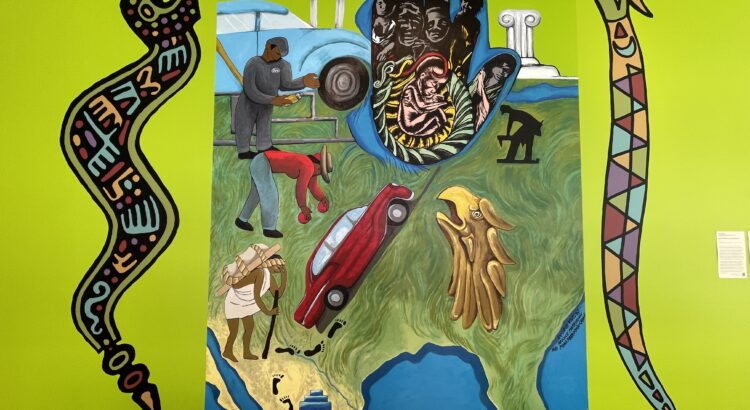Fifty years after its founding, the University of Michigan Museum of Art celebrates the legacy of La Raza Art and Media Collective, a trailblazing group of Chicano, Hispanic and Latino/a creatives. Founded in the 1970s, the group organized community gatherings and produced creative work, including a multimedia journal. Now, these works from the collective’s history are brought into conversation with the present, in La Raza Art and Media Collective: 1975–Today.
At the center of the exhibition is a collection of material from the early issues of RAM Collective’s journal, including original copies of artwork that have been preserved by the Bentley Historical Library. This collaboration brings a different kind of experience than viewers may be expecting at an art museum. There are gems of poetry, artwork and essay writing among the spread of pages, providing a fascinating glimpse into the lives of Latino/a students and artists from fifty years ago, but finding them requires a willingness to spend some time reading through small print.
However, visitors searching for dramatic visual impact will be more than satisfied with the gallery space itself. One wall is papered with silkscreen prints by U-M Stamps School of Art & Design professor and alum Nicole Marroquin (MFA ‘08), using more imagery drawn from the Bentley archives. Another is painted bright green and features a mural painted by George Vargas, a founding member of RAM Collective, along with Nicole Marroquin and Mina Marroquin-Crow. And the gallery’s two walls of floor-to-ceiling windows are adorned with ribbons of transparent film created by Michelle Inez Hinojosa (Stamps MFA ‘23) that give a colorful tint to the light flowing into the gallery and the view onto State Street. Together, they bring a bold and bright atmosphere to the exhibition, letting the vibrant history and present of the university’s Latino/a community spill out of the journal pages and onto the walls of the museum itself.

Of all the contemporary artworks created to accompany and transform the historical work of RAM Collective, a highlight is the collection of zines produced by Stamps School of Art & Design students, working in Nicole Marroquin’s Social Spaces class. These zines engage with the history of RAM Collective and the artists and communities involved, drawing on the Bentley’s archives to continue the mission of the collective in the present.
One zine, created by a group of students (Megan Fan, PingYu Hsu, Julian Kane, Jaden King and Violetta Wang), presents a selection of images from George Vargas’s sketchbook during his time as a graduate art student at U-M. The students write, “As art students ourselves, we became inspired by this work.” Another, produced by Liana Kaiser, presents a poignant collection of poems from a Detroit organization called La Casa de Unidad Cultural Arts and Media Center. Visitors are encouraged to take a zine with them when they leave, “so that La Raza Art and Media Collective carries on.”

The exhibition’s true strength is how it embodies the spirit of collaboration, coalition-building and solidarity that the original RAM Collective was founded on. The array of contributions from original members of the collective, more recent Stamps alumni and faculty, and current students brings multiple generations together to continue La Raza’s mission.
La Raza Art and Media Collective: 1975–Today is on view at UMMA through July 20th. All exhibition signage is presented in both English and Spanish.







